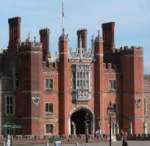|
Bought in 1514 from the Order of St John of
Jerusalem, Thomas Wolsey acquired the site
before becoming Cardinal and Lord Chancellor of
England. The then private residence, with a
staff of over 500, offered an opulence of
hospitality and entertainments that were the
wonder of Europe.

When Wolsey fell from favour, he presented
Hampton Court to Henry VIII, who moved into and
enlarged the Palace further from 1529.
The slendour of its finest Tudor architecture
and unique skyline, the Palace has dominated the
landscape of the river Thames, 15 miles
south-west of London, since the fifteenth
century. Surrounding the magnificent Palace
buildings are its glorious grounds and parkland.
 These
extensive lands, on the Middlesex bank of the
river originally made up the playgrounds
befitting the sport of Kings. Elizabeth I came
to live at Hampton Court in 1559 a year after
her accession. She kept up and improved her
father's gardens, benefiting from the rare
plants brought back from distant lands by
Raleigh, Drake and Hawkins. A century later
Charles 1, made the Palace his home for many
months of the year and favouring more
sophisticated entertainments whilst in
residence, set about a formal programme of
landscaping, introducing ornamental lakes,
ponds, fountains and canals. These
extensive lands, on the Middlesex bank of the
river originally made up the playgrounds
befitting the sport of Kings. Elizabeth I came
to live at Hampton Court in 1559 a year after
her accession. She kept up and improved her
father's gardens, benefiting from the rare
plants brought back from distant lands by
Raleigh, Drake and Hawkins. A century later
Charles 1, made the Palace his home for many
months of the year and favouring more
sophisticated entertainments whilst in
residence, set about a formal programme of
landscaping, introducing ornamental lakes,
ponds, fountains and canals. After the Civil
War, Charles’ execution, Cromwell’s death and
the Restoration, Charles II moved to the Palace.
He applied himself to the repair of the
fineries, art and decoration of the Palace. As
part of this stylish scheme, the gardens in the
Home Park were completely remodeled, with the
planting of Lime trees and the introduction of
cascades.

Samuel Pepys was a frequent visitor along with
other London society, who took refuge at the
Palace during the Great Plague in 1665. A year
later the Palace was used again to store
treasures while the Great Fire raged.
In 1689 after their arrival from Holland,
William and Mary set about redesigning the
Palace and grounds to rival the Palace at
Versailles and reflect more modern tastes. Using
European influences and modern tastes, Sir
Christopher Wren was set to work immediately. As
well as his buildings of great grandeur, the
clean air, pure water, spacious woods and
elegant grounds were much desired. The
opportunity it offered for the laying out of
gardens, arbours and tree-lined walks, made it
the favourite country home, hunting-lodge and
pleasure palace of successive generations of
English monarchs. Their personal tastes and the
genius of their artists, architects and
designers can still be seen in the buildings and
gardens and in the art treasures which fill its
rooms, galleries and halls.
Opened in 1932 and created by the celebrated
architect Sir Edwin Lutyens, its wide, shallow
span, allowed for open, continuous views, across
to the Palace and up and down the Thames.

Hampton Court Palace has borne witness to
every aspect of British Court history. Its
contribution to the fabric of our historic
understanding is priceless. Through the
centuries, our Royal forebears have stamped
their own indelible marks on the history of the
Palace and its lands. The Palace that we visit
today offers us all a unique window onto the
Britain of the past, both Royal and lowly. This
should be cherished, not only for its value to
our heritage, but simply for its survival.
|
